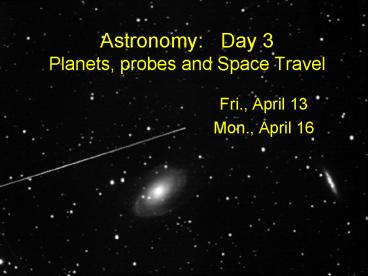Astronomy: Day 3 Planets, probes and Space Travel - PowerPoint PPT Presentation
1 / 23
Title:
Astronomy: Day 3 Planets, probes and Space Travel
Description:
Notes: Planets, space observatories, space travel and probes ... The Kuiper belt, (rhymes with 'viper') is an area of the solar system extending ... – PowerPoint PPT presentation
Number of Views:139
Avg rating:3.0/5.0
Title: Astronomy: Day 3 Planets, probes and Space Travel
1
Astronomy Day 3Planets, probes and Space
Travel
- Fri., April 13
- Mon., April 16
2
Agenda
- Notes Planets, space observatories, space travel
and probes - Activities Scale model of our solar system,
Designing space exploration
3
Upcoming Dates
- WASL Late arrival for Tues-Friday 4/17-4/20
4
Beginning of our Solar System
- Cloud of dust and gas collapses.
- Nebulas densest part grows larger and hotter
forms proto-sun. - Small bodies called planetesimals form.
- Planetesimals clump together to form
proto-planets. - Eight planets a dwarf planet emerge.
5
The planets
Planet stats D\Ch19\80323.html
6
Keeping it all in perspective
7
Keeping it all in perspective
8
Keeping it all in perspective
9
Keeping it all in perspective
10
Keeping it all in perspective
Antares is the 15th brightest star in the sky.
It is more than 1000 light years away.
11
The Inner Planets
- The inner planets are called terrestrial planets.
- A terrestrial planet is one of the highly dense
planets nearest to the sun Mercury, Venus,
Earth, and Mars. - Distances in the solar system are often measured
in terms of the distance from Earth to the sun,
which is one astronomical unit (AU), or 150
million km. - Mercury has extreme temperatures.
- Its day is 58 Earth days its year is 0.24 Earth
years. - It has almost no atmosphere and no water.
12
The asteroid belt
- Between Mars and Jupiter is a band of asteroids
rocky or matallic fragments that never formed a
planet. - Asteroids range in size from a few feet in
diameter to hundreds of miles. - A collision with an asteroid would be
catastrophic to Earth, creating tidal waves, huge
forest fires, or great clouds of ash and dust
that could block out the sun for months at a time.
13
The Outer Planets
- The planets most distant from the sun are
Jupiter, Saturn, Uranus, and Neptune. - These large planets are called the gas giants.
- A gas giant is a planet that has a deep, massive
atmosphere and no solid surface. - Neptune was first discovered in 1846
- Its period of rotation is 16 hours, 7 minutes.
- Its period of revolution is 163 years, 263 days.
14
Pluto
- Discovered in 1930, Pluto is very small and icy,
unlike either the rocky planets or gas giants. - Some scientists belive Pluto to be an icy
planetesimal formed in the Kuiper Belt, a region
beyond the orbit of Neptune.
15
The Kuiper belt, (rhymes with "viper") is an area
of the solar system extending from the orbit of
Neptune (at 30 AU) to 50 AU from the Sun.
16
(No Transcript)
17
Space Observatories
- 1962 The first of many space telescopes, the
Orbiting Solar Observatory, was launched. - In 1990 NASA launched the first of 4 Great
Observatories including - Hubble Space Telescope (visible, ultraviolet and
part of the infrared) - Chandra X-ray Observatory
- Compton Gamma-ray Observatory
- Spitzer Space Telescope (long wave infrared)
18
(No Transcript)
19
Visiting Space
- Sending humans into space is a very complex task
that takes years of engineering to prepare for.
There are numerous considerations involved
ranging from how to get the craft where it needs
to be to what the craft needs to be able to do
when it gets there, including supporting the life
it carries.
20
Visiting Space
- In 1957, Soviet Yuri Gagarin orbited Earth
- In 1968, the Apollo 8 mission allowed 3 American
astronauts to orbit the moon. - In 1969 the Apollo 11 mission landed the first
humans on the moon. - Since the 1980s there have been numerous space
shuttles and space stations orbitting earth.
21
Probing Space
- To explore beyond the moon, scientists have
relied on robot probes. - Some probes are orbiters and some are Landers.
- Launching a spacecraft at a distant planet is
extremely difficult. Both earth and the planet
are moving. Its like threading a needle from
across the room.
22
Probing Space
- All 8 planets have been visited by at least one
probe. Pluto has not yet, but the New Horizons
probe launched on 19 January 2006. It flew past
Jupiter on 28 February of this year, getting a
kick from the planet's gravity to help it reach
Pluto in 2015. - Voyager 1 is more than 9 billion miles from
Earth. Launched in 1977, it visited Jupiter and
Saturn in 1979-1980 and is now heading toward the
edge of the solar system. It is expected to send
back data until at least 2020.
23
Activities
- Scale model of solar system
- Designing Space Exploration































